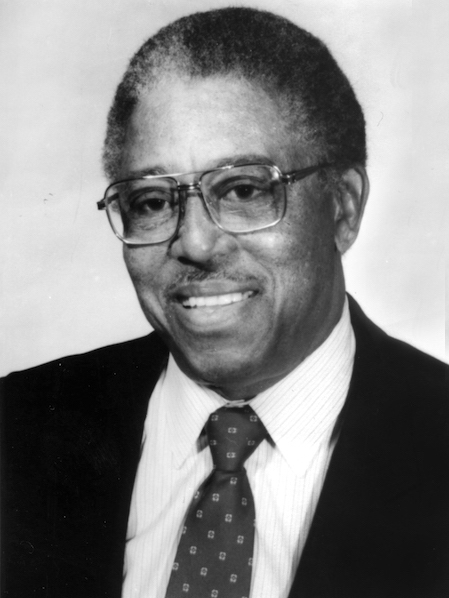John Saunders Chase, FAIA (1925–2012) was a Houston architect who realized a large body of work in the city, throughout the state of Texas, and around the United States. At its peak, his office had nearly fifty employees in four cities: Houston, Dallas, Austin, and Washington, D.C. Chase, an African American in a profession that has struggled with diversity and discrimination, achieved many historic firsts during his career. His life, as seen via his personal and professional achievements and the work of younger architects who passed through his office, was on display this spring in Chasing Perfection, a two-part exhibit produced by the Houston Public Library.
Born in Maryland, John Chase moved to Austin in the late 1940s after receiving initial architectural training at the Hampton Institute in Virginia and serving in the Army during World War II. He applied to graduate school at the University of Texas at Austin (UT Austin) School of Architecture after the Sweatt v. Painter Supreme Court decision in 1950 that fought the “separate but equal” policy of racial segregation in college education. After graduation, no firm would hire him, so Chase established his own practice in Houston, and in 1956, he became the first African American architect to be licensed in the state. Throughout his career, he designed churches, homes, union halls, libraries, high schools, fire stations, and institutional buildings, including much of the campus of Texas Southern University. He was a founding member of the National Organization of Minority Architects (NOMA) in 1970 and received his AIA Fellowship award in 1977. In 1980, Chase was selected by President Jimmy Carter to join the Commission of Fine Arts and was part of that committee during the contentious process of realizing Maya Lin’s Vietnam Veterans Memorial on the National Mall. He was the first African American to serve on this commission. During the 1980s, his office was part of a consortium of local architects responsible for the design of the George R. Brown Convention Center in Houston. Chase is survived by his wife, Drucie, and their three adult children.

According to Danielle Wilson, the exhibition’s curator, discussions about the show began in 2009 with Chase’s participation. At that time, his architectural archive had been donated to the Houston Metropolitan Research Center’s Architectural Archives, and his personal archive was in the process of being donated to the African American Library at the Gregory School. Wilson’s father grew up next to the Chases in Houston, so she was familiar with the family and immediately knew that she wanted to work on a show about the architect when she joined the staff of the Gregory School. After Chase passed away, it took a number of years to assemble the parts for this successful exhibition.
On the second floor of the Julia Ideson Building in downtown Houston, letters, photographs, and artifacts were installed alongside photographs of built work, architectural drawings, and hand-drawn renderings. Seen together, Chase’s life and work could be understood through the staging of these personal and professional artifacts, sequenced together to tell a holistic life story. Wilson said, “When I think about architects and their work, everything goes all together. I think it’s great when you have that context of both. I think it makes works more powerful.” The room also included a large–scale model and drawings of the George R. Brown Convention Center mounted on a drafting table.
At the Gregory School, the work of four architects who worked with Chase is on display and demonstrates the effect his mentorship had on a subsequent generation of African American architects. “When I was focusing on his work and life, it was hard to tell a comprehensive narrative without talking about these men,” Wilson said. Daniel Bankhead, AIA; Darrell Fitzgerald, FAIA; James Harrison; and Wilbert Taylor all worked at various points with Chase and went on to become professional and community leaders themselves. In February, the library hosted a discussion between these architects, in addition to a conversation with Mrs. Chase and her children.

Chasing Perfection offered a powerful portrait of a 20th–century American architect through Chase’s life, work, and impact on the profession. Wall text for the exhibit was excerpted from a manuscript titled The Life and Work of Architect John Saunders Chase: You Can Do More from the Inside, by architectural historian Dr. Wesley Henderson with Andrea Lazar. Both worked for two years to conduct interviews with family members, colleagues, and former employees of John Chase. Henderson and Lazar believe that Chase’s life story deserves to be more widely known since very few biographies of successful black architects have been published. They were very pleased to be able to contribute to the show at the Houston Public Library.
Chase’s legacy continues to be explored and celebrated. In February, UT Austin announced that it had purchased one of Chase’s early buildings in east Austin to renovate and use as a community engagement center. While Chasing Perfection closed in early June, Wilson says there are already discussions underway about touring the show at other institutions. She also said a brochure from Chase’s firm and drawing supplies from his office were recently acquired by the National Museum of African American History and Culture (NMAAHC) in Washington, D.C. Wilson added that she and Mrs. Chase are “going to go through his personal archives to see what materials might go to the NMAAHC, and the rest will be housed at the African American Library at the Gregory School.”
Chase is an important figure among the talented architects who practiced in Houston during the second half of the 20th century. His career opened the door for many architects of color to enter the profession, and he serves as an example of the countless ways in which an architect can effect positive change in the world.
Chasing Perfection: The Work and Life of Architect John S. Chase
Houston Public Library
Julia Ideson Building
Chasing Perfection: The Legacy of Architect John S. Chase
The African American Library at the Gregory School











